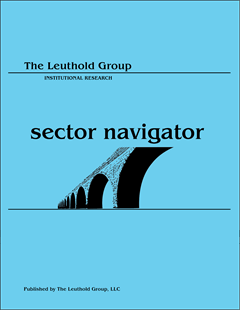Risk Aversion Index
Risk Aversion Index: Stayed On “Lower-Risk” Signal
Despite the “Lower-Risk” signal, the surge in bond yields and a higher U.S. dollar have materially tightened financial conditions: Caution is strongly recommended.
Risk Aversion Index: Stayed On “Lower-Risk” Signal
The Risk Aversion Index ticked up in August, but its “Lower-Risk” message is unchanged. Within fixed income, we remain constructive on shorter maturity and higher-quality credit.
Risk Aversion Index: Stayed On “Lower-Risk” Signal
The rally in risky assets became even more broad-based, with small caps and EM participating fully.
Risk Aversion Index: New “Lower-Risk” Signal
The risk rally has survived a wide range of challenges, including renewed central bank hawkishness, and tighter credit/bank-lending standards, among others. “Soft landing” is still the key narrative that supports the current rally.
Risk Aversion Index: Stayed On “Higher-Risk” Signal
Despite an AI-fueled equity rally, an imminent liquidity reduction and ongoing bank-credit tightening are serious headwinds for risky assets in the near term.
Risk Aversion Index: Stayed On “Higher-Risk” Signal
Despite the resilience in most risky assets, the recession probability has increased and the prospect of further credit tightening has only added to the downside risk.
Risk Aversion Index: Stayed On “Higher-Risk” Signal
Inflation concerns have been pushed aside by the upcoming curtailment of credit and lending. The possibility of a recession has no doubt increased, and risky assets are apt to face challenges.
Risk Aversion Index: A New “Higher-Risk” Signal
Inflation worries have rekindled expectations for additional rate hikes. Providing this dynamic is still in play, risky assets are apt to face challenges.
Risk Aversion Index: Stayed On “Lower-Risk” Signal
Seasonality is still an advantage, and financial conditions have eased. Within fixed income, we remain favorable toward both Treasuries and higher-quality investment-grade corporate bonds. We maintain a neutral stance on the yield curve.
Risk Aversion Index: Stayed On “Lower-Risk” Signal
While seasonality remains favorable, the risk of a severe recession looms large in the medium term. We are favorable toward high-quality corporate credit and Treasuries.
Risk Aversion Index: Stayed On “Lower-Risk” Signal
The market has responded quickly to global central-bank pivots, and favorable seasonality can carry the rally a bit further in the near term. However, the risk for a severe recession still looms in the medium term.
Risk Aversion Index: A New “Lower-Risk” Signal
Given depressed market sentiment and favorable seasonality, near-term prospects look better for risky assets.
Risk Aversion Index: Stayed On “Higher-Risk” Signal
The risk of a policy error is the top concern as the Fed doubles the pace of Quantitative Tightening, even with the U.S. technically in a recession. Caution is recommended.
Risk Aversion Index: Stayed On “Higher-Risk” Signal
The risk of a policy error is extremely high as the Fed stays on an aggressive tightening path even with the U.S. in a “technical” recession. Caution is recommended.
Risk Aversion Index: Stayed On “Higher-Risk” Signal
The risk of a policy error is elevated as the Fed stays on an aggressive tightening path even though growth materially slows. Caution is recommended.
Risk Aversion Index: Stayed On “Higher-Risk” Signal
While inflation might have peaked, a material slowdown looks more certain as the Fed stays on an aggressive tightening path. Caution is warranted.
Risk Aversion Index: A New “Higher-Risk” Signal
As long as the Fed stays on the current aggressive tightening path, caution is highly recommended.
Risk Aversion Index: Stayed On “Lower-Risk” Signal
With the Fed still on a tightening path, caution is still recommended. Among fixed income, we remain neutral on TIPS but have turned favorable toward EM bonds.
Risk Aversion Index: A New “Lower-Risk” Signal
Despite continued weakness in equities and a higher reading in our Risk Aversion Index (RAI), it generated a “Lower-Risk” signal.
Risk Aversion Index: Stayed On “Higher Risk” Signal
Lofty valuations amid shrinking liquidity conditions make all risky assets vulnerable.
Risk Aversion Index: Stayed On “Higher Risk” Signal
The impact of Omicron is already fading and the global-tightening cycle is far more important going forward. Elevated valuations amid a broadening global-tightening cycle is our key concern.
Risk Aversion Index: New “Higher Risk” Signal
With the market getting less sensitive to each iteration of new variant, we believe the impact of Omicron is unlikely to be as significant as the global-tightening cycle.
Risk Aversion Index: New “Lower Risk” Signal
With seasonality once again turning positive and inflation breakeven rates bumping above the recent range, we continue to favor the reflation trade.
Risk Aversion Index: Stayed On “Higher Risk” Signal
Elevated valuations and a global tightening cycle are usually not a favorable context for risky assets. Within fixed income, we remain positive toward TIPS and cautious on credit.
Risk Aversion Index: Stayed On “Higher Risk” Signal
The reflation trade stayed in a holding pattern with breakeven rates remaining range bound. Within fixed income, we are favorable toward TIPS and cautious on credit.
Risk Aversion Index: A New “Higher Risk” Signal
Our Risk Aversion Index moved higher and generated a new “Higher Risk” signal. Within fixed income, we are favorable toward TIPS and cautious on credit.
Risk Aversion Index: Stayed On “Lower Risk” Signal
With the looming Fed taper and valuations stretched on almost all risky assets, volatility is likely to increase in the near term. Among fixed income, we are favorable toward TIPS and cautious on credit.
Risk Aversion Index: Stayed On A “Lower Risk” Signal
The talk of taper has started to resurface. In this context, higher inflation might become a negative for credit. For now, we remain favorable toward TIPS but turn cautious toward credit.
Risk Aversion Index: A New “Lower Risk” Signal
The reflation trade continued with higher breakeven rates and lower real yields, a favorable make-up for risky assets.
Risk Aversion Index: Stayed On “Higher Risk” Signal
The reflation theme continues to be supported by the powerful policy mix and a successful vaccine rollout. Within fixed income, we are favorable toward TIPS and short-term high-yield credit.
Risk Aversion Index: A New “Higher Risk” Signal
While mechanical signals generated from extremely low RAI levels can be noisy, extended valuations on most assets suggest we err on the side of caution.
Risk Aversion Index: Stayed On “Lower Risk” Signal
We remain favorable toward credit including investment grade and high yield corporates.
Risk Aversion Index: Stayed On “Lower Risk” Signal
We remain favorable toward credit and recommend both investment grade and high yield corporates.
Risk Aversion Index: A New “Lower Risk” Signal
With election risk largely in the rear-view mirror, volatility has come down across most asset classes, contributing to the drop in the RAI.
Risk Aversion Index: Stayed On “Higher Risk” Signal
We are cautious near term and recommend playing defense through duration reduction within corporate credit (including both investment grade and high yield).
Risk Aversion Index: New “Higher Risk” Signal
Treasuries’ ability to provide downside protection has weakened; a better way to play defense is probably through duration reduction within corporate credit (including both investment grade and high yield).
Risk Aversion Index: Stayed On “Lower Risk” Signal
The breakeven rates capture the spirit of the overall risk rally and continue to provide support. The change in the Fed’s policy goals means it will remain accommodative for even longer.
Risk Aversion Index: Stayed On “Lower Risk” Signal
With “reopening” taking a pause, we expect global policies to remain accommodative even longer. Among fixed income, we like corporate credit, which includes both investment grade and high yield bonds.
Risk Aversion Index: Stayed On “Lower Risk” Signal
While the market seems to have priced in a quick recovery, recent economic data has materially exceeded market expectations and provided support to the rally. Within fixed income, we maintain a favorable view toward investment-grade corporate bonds and we still recommend staying within range of the Fed’s fire power.
Risk Aversion Index: New “Lower Risk” Signal
Our Risk Aversion Index fell sharply in May and generated a new “Lower Risk” signal. Within fixed income, we are turning more constructive on credit, overall, and maintain our favorable view toward investment-grade corporate bonds.








































